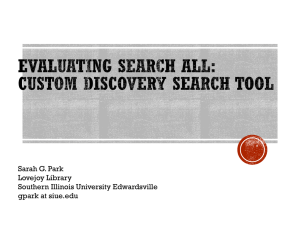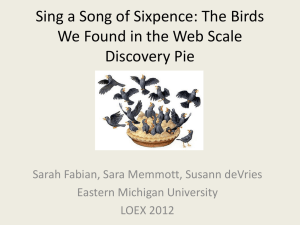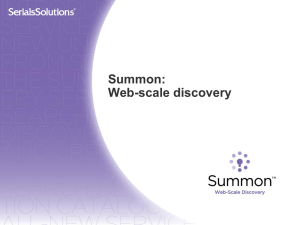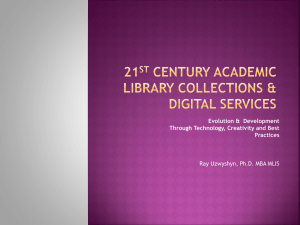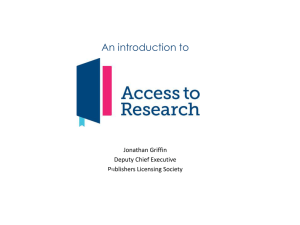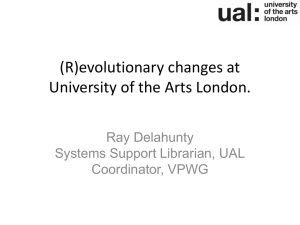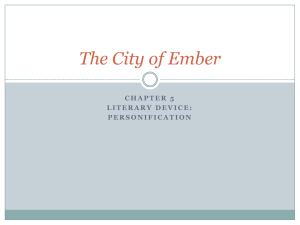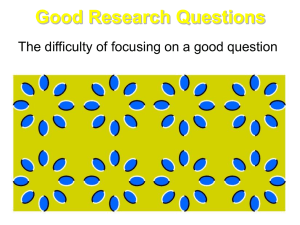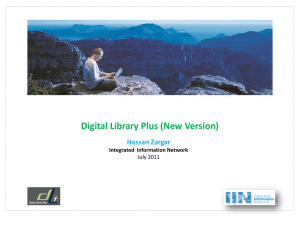Turkey - HEAL-Link
advertisement
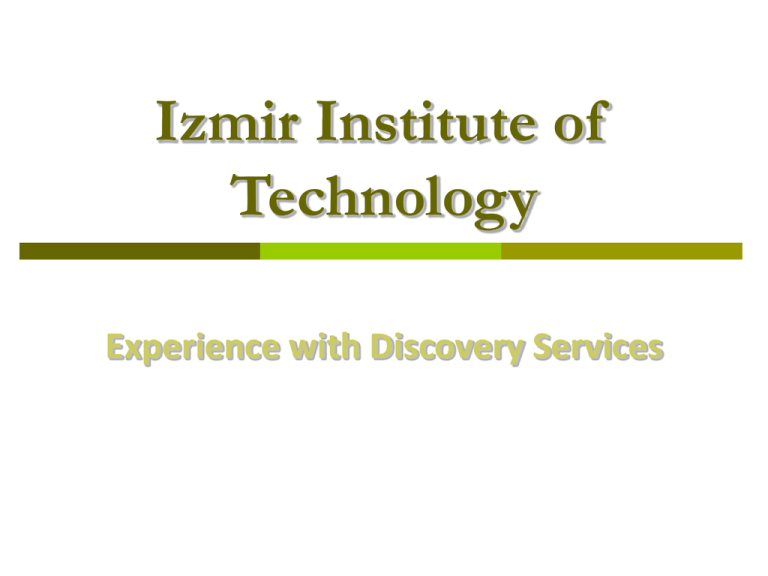
Izmir Institute of Technology Experience with Discovery Services SUMMON OR EDS We began to use the SUMMON on 23 March 2010 as a beta partner. We began to use the EBSCO Discovery Services (EDS) on 24 May 2010 as a trial. We decided to subscribe to SUMMON at November 2010 after negotiating the price. (We compared SUMMON price with EDS price also.) Some Examples (29 July 2010) Example 1: Journal of Architectural Education (1984) (1046-4883) from 1984 to 1999 in JSTOR from 1999 to present in Wiley-Blackwell from 01/09/1999 to 1 year ago in Academic Search Complete from 01/09/1999 to 1 year ago in Humanities International Complete The Number of Articles – The First Page Full-Text Articles The Number of Articles – The Last Page Date (Oldest) Full-Text Date (Newest) Full-Text EDS 2324 1360 614 1999 May.09 SUMMON 831 831 1999 Mar.10 Some Examples (29 July 2010) Example 2: Communications on Pure and Applied Mathematics from 1996 to present in Wiley-Blackwell The Number of Articles – The First Page EDS SUMMON Full-Text Articles The Number of Articles – The Last Page Date (Oldest) -Full-Text Date (Newest) Full-Text January 1997 September 2010 Not found 801 801 Some Examples (29 July 2010) Example 3: Advanced Materials (Weinheim) (0935 – 9648) from 1998 to present in Wiley-Blackwell EDS SUMMON The Number of Articles – The First Page 39.975 18.179 Full-Text Articles The Number of Articles – The Last Page Date (Oldest) -Full-Text Date (Newest) Full-Text 23.459 8.024 July 1996 July 2010 August 1996 July 2010 18.179 18.064 (Until the page of 20) THE NOTES ABOUT SUMMON 1- All the records from IYTE catalog didn't come in the Summon. For example we searched at "Kemal Sunal" both IYTE cataloging and SUMMON. There were 17 records in the IYTE catalog. But there were 14 records in the SUMMON. Also we couldn't find this article anywhere: 350,000 ILLEGAL ALIENS LEAVE SAUDI ARABIA: 2 Edition (Washington Times ISSN: 0732-8494 Date: 07/05/2000 Description: A.10) According to 360Link result, we could have found it Newspaper Source or Regional Business News but we couldn't. Also Newspaper Source or Regional Business News doesn't have any issues in the “Washington Times” the date of 07/05/2000. 2- We searched at "Comedy film" both IYTE cataloging and SUMMON. There were 223 records in the IYTE catalog. But there were 203 records in the SUMMON. THE NOTES ABOUT SUMMON 3- We searched at "A hybrid fuzzy goal programming approach with different goal priorities to aggregate production planning" in the SUMMON. There were two records: But we couldn’t find the second record according to this data. THE NOTES ABOUT SUMMON 4- We searched at “Journal of Intelligent & Fuzzy Systems” in the SUMMON. Publisher of this journal is Springer and we can access all issues from 1997 to present. We noticed that we could access only the year of 2009 in the SUMMON. We needed to know access years of all journals which we subscribe, according to SUMMON aggrements. Besides, we needed to know which journals which we subscribe couldn’t be accessed in the SUMMON. THE NOTES ABOUT SUMMON 5. The search results haven’t been included item number. We think that item number should be written… 6. Some of the records didn’t include abstract. Preview Journal Article Credits Author: Anonymous Publication Title Presidential Studies Quarterly Date 12/2009 Volume 39 Issue 4 Start Page 0_3 ISSN 0360-4918 Genre Credits, Credits Language English Summon Beta and feedback/ issues raised Date: 29th August 2010 Summary of questions raised: Serials Solutions response: 1. Does summon search both fulltext and Bibliographic content? - Yes. 2. Can Both fulltext and bibliographic content be searched at the same time? - Yes. 3. If IYTE requests can summon search only bibliographic content? - No. 4. What is the meaning of “Add results beyond your library's collection” filter? - Summon is unique in the way it is set-up as all Summon users search across the same Summon index containing the same body of content. However, based on our knowledge of the library’s holdings information, Summon only displays to the user search results for content that the library has access to (plus their catalog and other local collections). This ensures that your users only see results from your library’s collection. When a user chooses to “add results beyond your library’s collections” the results set expands to include all materials in the entire Summon index (with the exception of all of the catalogs from other libraries). To try to clarify the example above, if a user searches “Bill Clinton” at Dartmouth College’s Summon site one gets: - 1,168,071 results. Dartmouth users have access to all of these results. -If a the user then clicks Add “results beyond library collection” the results set expands to 2,335,428 results which includes everything in the Summon index related to the user’s “Bill Clinton” query regardless of whether users at Dartmouth have access to that material or not. If a user tries to access an article that Dartmouth users do not have the rights to, they will get a message from the library’s link resolver telling them that they do not have access to that article. Running a blank search on any Summon site, scoped to “beyond your library collection” showcases all of the content in the Summon index (almost than 500,000,000 items). Summon Beta and feedback/ issues raised Date: 29th August 2010 5. Do you have any list of titles that overlap between IYTE and Summon with coverage dates? (for example IYTE can access a title between 1997-2010 and summon also covers this title with different coverage 2000-2009 so 2 years is missing so IYTE wants to see this partial overlapping ) - For the vast majority of content partners that Summon works with, we get the full run, full coverage dates so that matching coverage years to IYTE should not be an issue. The vast majority of our article content is indexed in full text, which means that it is full text searchable. As content coverage changes all the time, we do not yet have a list that we can share that shows what is full text or just metadata (bibliographic content). We will have this soon. 6. How many records has only bibliographic content (no fulltext content) in SUMMON? - The vast majority of our article content is indexed in full text, which means that it is full text searchable. As content coverage changes all the time, we do not yet have a list that we can share that shows what is full text or just metadata (bibliographic content). We will have this soon. As a follow-up to question 3 above, we are curious why your library would be interested in just search bibliographic data only? From the user perspective it should not matter if they are searching the full text or the metadata only. What matters is that Summon is making this material discoverable and allowing users to zoom in on relevant results. If the libary has access to an article or resource in full-text, Summon will link the user to the full-text in the library’s collection via the Link Resolver, regardless of whether the information in Summon is indexed in full text, as metadata only, or as a combination. Summon Beta and feedback/ issues raised Date: 29th August 2010 7. What is the meaning of “Library location” facet? If it means library records it is wrong because numbers are completely different from library catalog. - The library location facet displays bases on information in the location field of your Marc records, based on the results returned for the users query. In some cases it is possible that the same query in Summon performed in your catalog may return different results. If this seems to be a problem or locations are not correct, we will need to work with you to investigate further. 8. When will ULAKBIM databases be ready in SUMMON? - A legal agreement has been sent to ULAKBIM and is waiting for signature by them When content is indexed in Summon varies by publisher and provider. Serials Solutions strives to get all content in Summon as soon as possible, but content must be mapped to our schema for indexing. The speed at which new content providers get indexed is dependent on the quality and format of the metadata we receive from the vendor/publisher. Serials Solutions puts all of our metadata through an exhaustive normalization, correction and de-duplication process before it is every indexed. We cannot comment on how fast the new content will be in Summon until we have seen what the vendor/publisher provides to us. We can update you when we know more. Summon Beta and feedback/ issues raised Date: 29th August 2010 9. Ebscohost’s non journal content list attached. This list includes 34028 titles in it. Does Summon cover these titles? If yes, which ones? As you will see below and in the attached documents, we have attempted to answer this question in several ways. Serials Solutions does not index content on a per-database level or per-content vendor, nor do users who use a discovery service search across content in this way. As such we are very thorough and careful when providing content comparisons. Serials Solutions performs content analysis using different methodologies and then provides this data to the library so that the library can make a complete assessment of coverage levels in our service – especially in comparison to the library’s actual holdings as opposed to a vendor’s title list. First, please note that we have provided a complete coverage analysis of IYTE holdings information as managed in the Serials Solutions Client Center. It is critical to weigh this question in the context of how much of your library’s collection as whole is searchable in Summon and how much is searchable in Summon that goes far beyond what EBSCOhost is capable of searching. A Summary of these results is below, with more details in the attached documents. Serials Solutions entire collection title level analysis We did an assessment of the 47,291 titles we track for you in the Serials Solutions Client Center of which 36,654 items are journal titles with ISSN or eISSN numbers. There were 23,703 unique ISSN that we analyzed after de duplication removed 12,951 records. The de-duplication suggests that there is some overlap in the collection and perhaps some money that can be saved by the library with further overlap analysis. Summon Beta and feedback/ issues raised Date: 29th August 2010 Of the titles analyzed with active ISSNs, only 2,265 items are not yet covered in Summon. And of these titles not yet in Summon, only 714 titles are peer-reviewed sources. A file representing the titles not currently in Summon is attached for your review. No matter how you interpret these numbers, Summon covers more than 91-95% of your journal collection. In addition, there were just over 10,600 titles without ISSNs that will require further analysis. Of these titles, we can be assured that at least 3,357 titles are fully covered in Summon based on our content partner relationships. From the remaining 7,200 titles without ISSNs we will likely have partial coverage of about 1,500 titles. The Remaining titles without ISSN consist of over 5,700 titles from Business Source Complete which are largely individual Company reports and SWOT analyses. Spot analysis of EBSCO provided list We have also analyzed the 34,000+ title list of “non-journal” content provided by EBSCO and can verify that Summon does cover some, but not all of this content. The numbers below should be taken into context with the full holdings coverage analysis data provided above. Of the titles provided, we did note that there were 2,157 items with ISSNs. Of these items only 326 items are not yet in Summon and only 8 of these are peer-reviewed. If desired we can provide a file indicating which of these titles is/is not covered. The remaining 31,866 non-journal titles consist of roughly 18,096 items with no ISSN/ISBN numbers and 13,772 “books” with ISBN numbers. The vast majority of the 18,096 non-ISBN content are Industry Reports and SWOT Analyses from Datamonitor PLC (8,440 items) and ICON Group International (3,933 items). Of the 13,772 “book” items there are 8,896 World Outlook Reports from ICON International, Inc. We expect to have full or partial coverage of about 1,059 of the remaining book items based on our content partner agreements, however further analysis of these titles would be needed. Summon Beta and feedback/ issues raised Date: 29th August 2010 10. Ebscohost indexes 68284 fultext and bibliographic records in the databases. - It is not clear what exactly the question or concern is here regarding EBSCOHost. EBSCOhost content only makes up approximately 50% of journal content that IYTE subscribes to. Still, Summon indexes 85-95% of this EBSCO content plus the majority of the rest of the content that IYTE subscribes to from other sources. As EBSCO is merely an aggregator, not a publisher, the EBSCO content in Summon comes directly from publishers or other aggregator sources. Summon has pre-indexed almost 500,000,000 items. The Summon index represents material from dozens of content types, from over 6,800 publishers. Serials Solutions works directly with publishers to index their content in Summon and is not reliant on working with content aggregators like EBSCO. The vast majority of article content in Summon is indexed in full-text. The index also includes vast amounts of Open Access content and digital collections from other libraries which IYTE Library could make discoverable for its users. The Summon service searches across this full body of indexed content without regard to the source, publisher or vendor of the content. It returns a set of relevance ranked results that are scoped for your users based on the holdings information we have about your the library’s collection. If users try to access the full content of an article, the library’s link resolver will point them to the database or databases where your users have access to this material (ie. EBSCO databases). Please see the attached “How Summon works overview document” for more information and a simplified explanation of how Summon works and what is represented in our index. If you are referring to what EBSCO Discovery Service (EDS) has pre-indexed, this is nowhere near the scale of what Summon is doing. EDS returns pre indexed results from EBSCO databases, but then relies on federated search technology (EBSCO Integrated Search) for results from other resources. This hybrid model has severe limitations for the user in terms of user experience and access to content. Once a user attempts to integrate results outside of EBSCO, they can only get 30 results at a time for the federated resources + a mere 150 EBSCOhost results. This is not the level of results you would expect from a true web-scale discovery service. Summon Beta and feedback/ issues raised Date: 29th August 2010 11. In the Summon, maximum supported page number is 20. We can't see after than. Summon is designed to meet the needs and expecatations of most users. As it is not practical or typical user behavior to scroll through 20 pages of results, we have set this functionality to a maximum of 20. This could possibly be changed in the future, but with over 120 customers worldwide, no one has yet to think this is an issue. Summon is designed to provide more granular and intuitive facets and limiters than any other discovery solution. The vast majority of users never scrolls past the first page of results because the facets, limiters and refine search options allow them to zoom in on relevant results for their query. Users tend to refine searches before scrolling through all of the different pages of results. 12. The number of total search results change according to the first page, the last page, sort by date newest, sort by date oldest, results per page 25 or 50 etc. This is a known issue that is related to one step of our deduplication process. It is something that will be corrected soon and is a little more complicated than one would think. As an example, notice how Google handles results counts. They never provide an exact number, they just say “about 4,600,000 results.” http://www.google.com/#hl=en&q=philosophy Focus Group for SUMMON and EDS 1. The response time for queries (SUMMON + EDS - ) 2. To show the number of contained materials by category for search results (SUMMON + EDS - ) 3. To view of the contents without losing search results (SUMMON + EDS + / But the content can be opened in a new page in the SUMMON also) 4. Showing the number of material contained in the filter according to Search filtering options (SUMMON + EDS - ) 5. Ease of use, the option to “Add to Folder” (SUMMON + EDS - ) 6. Ease of transaction not to send the user to a new page (SUMMON + EDS - ) 7. User assistance about the use of the site – Help menu (SUMMON + EDS + / EDS is better than SUMMON) 8. Close to achieving a goal sought – Relevancy (SUMMON + EDS - ) 9. Page design (SUMMON is orderly. EDS is dispersed) SURVEY FOR SUMMON Totaly 26 answer 1. While researching, which source do you start the first? a) Google (21 - Person) b) The Library Web Site (4 - Person) c) SUMMON (No answer : 1 - Person) 2. Where do you start your research on the library web site? a) Databases page (12 - Person) b) IYTE Cat (9 - Person) c) SUMMON (1 - Person) d) E-Journals (1 - Person) (No answer : 3 - Person) 3. Do you have information about SUMMON? a) Yes (5 - Person) b) No (21 - Person) 4. Do you use SUMMON? a) Yes (5 - Person) b) No (21 - Person) If yes, please continue… SURVEY FOR SUMMON 5. What is the frequency of your use of SUMMON? a) My all searches (1 - Person) b) Frequently (1 - Person) c) Occasionally (3 - Person) 6. What do you think about the interface of SUMMON? a) Excellent (1 - Person) b) Good (4 - Person) c) Bad d) Very bad 7. Do you get the information you need, while researching on the SUMMON? a) Generaly (4 - Person) b) Occasionally (1 - Person) c) Never 8. Do you use the refine and limit options on the SUMMON search results screen? a) Yes (4 - Person) b) No (1 - Person) SURVEY FOR SUMMON 9. 10. 11. Do you need training for SUMMON? a) Yes (2 – Person) b) No (3 – Person) What is your general ideas and suggestions about SUMMON? -Easy to use (Only 1 answer) What is your special name suggestion for SUMMON? -LibFind (Only 1 answer) USAGE (January) USAGE (February) USAGE (March) USAGE (April) USAGE (May) Top Queries (May) FUTURE PLANS After the results of the survey, we realized that we have to create more awareness about the SUMMON. Our plans for this : - To announce a contest-winner for the most interesting & creative name for SUMMON. - We’ll enamble the summon search box in new designed library web site. - We’ll place the summon search box in the databases web page.
